Menu
How To Do A Backhand Serve In Badminton - Everything You Need To Know!
The serve in badminton is used to start the rally, and there are four different types: a low serve, flick serve, drive serve and high serve. The low serve, flick serve and drive serve can all be performed using a backhand serve.
The backhand serve is most commonly used in the doubles categories, though is often seen in the singles categories too. It can have varying trajectories depending on the type of serve used.
A good backhand serve helps give you an advantage from the start of the rally. To perform it, use a backhand grip and hold the shuttlecock with your thumb and index finger. You should then move your racket backwards and forward in one short motion.
Article Contents
Why The Serve Is So Important In Badminton
From studying over 200 professional and amateur doubles matches, we found an average of 59% of rallies were over in the first 4 shots, and many of these were service errors. This is a very high percentage and shows how important the role of the server is in badminton!
Having a consistent, effective serve can:
- Reduce the amount of points you lose,
- Help set you up for the rally ahead,
- Or even help you quickly win the point within the first 2 or 3 shots of the rally.
Q: Why is the backhand serve better than a forehand serve in doubles?
It is easier to control the serve when using a backhand grip, since the technique allows for a shorter swing with more precision.
The Service Preparation (7 Steps)
Step 1: Start with a backhand grip, holding the racket slightly higher up on the grip – the shorter lever will give you more control over the serve.
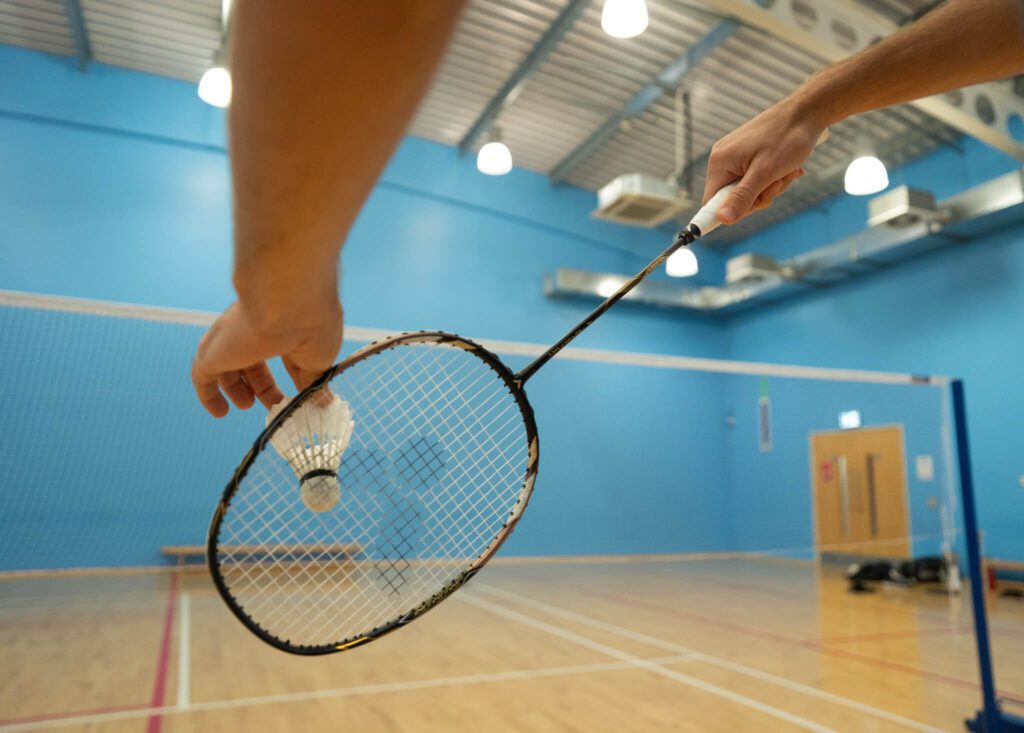
Step 2: Have your racket at around a 45-degree angle, as shown in the picture below.

Step 3: Have some space in between your racket and body to allow for a small backswing.
Exactly how much space you leave is down to your personal preference – we’ve seen some players almost entirely outstretched, and some quite tucked in; there are many different techniques that can be used, so we recommend experimenting to find what works best for you.
Step 4: Hold the shuttlecock with your thumb and index finger, about halfway down the feather (this is so that you can have a good grip of the shuttle, but equally you can move your fingers out of the way when you strike the shuttle!
Step 5: The angle you hold the shuttle is also very important. It should be roughly facing this direction:

This is because:
- If you hold the shuttle with the cork facing the floor, then you’re more likely to either hit your thumb or you’ll hit your flick serve too high and give your opponent too much time to get behind the shuttle and play an attacking shot.
- If you hold the shuttle with the cork facing towards you too much, you’re more likely to either hit it in the net, or do a very flat flick serve.
- If you hold the shuttle sidewards, then you’ll hit the feathers and lose control of the shot.
Step 6: How you stand when performing the backhand serve is down to your personal preference, but the most common way is to stand with your racket leg in front, or your feet side by side.
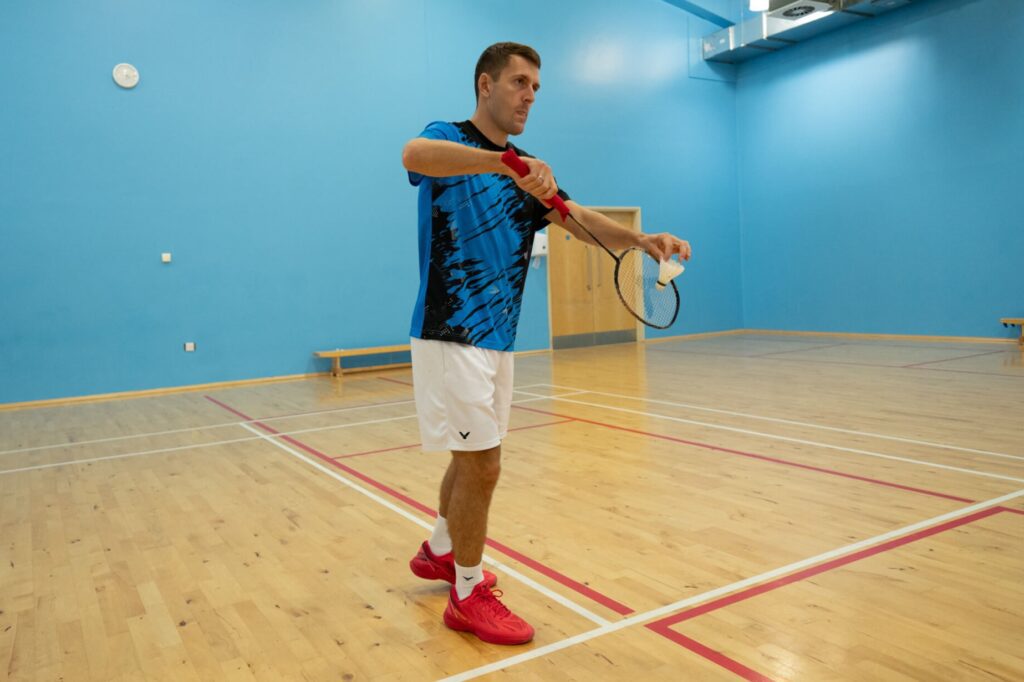
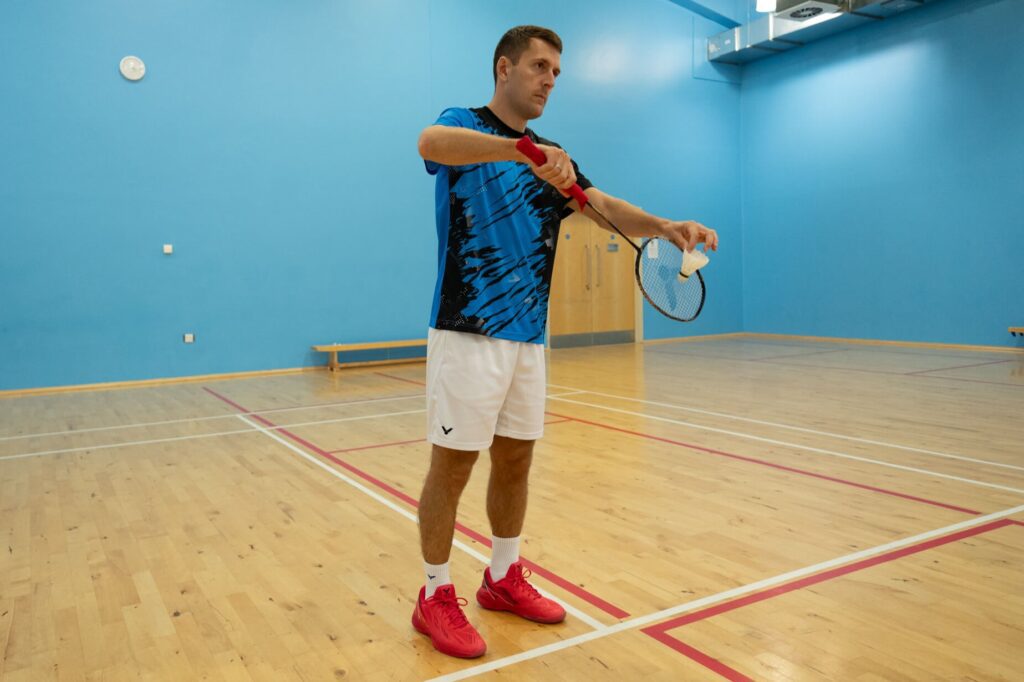
We’d encourage you to experiment and do what feels comfortable for you, as long as you are ready to move as soon as you have served.
Step 7: Stand close to the service line. This is the shortest distance for the shuttle to travel, meaning your opponent has less time to react once you hit your serve, and you can quickly move forwards to cover the net after serving too. However, in certain situations you would stand further back – such as if you’re playing singles or if you’re the male playing mixed doubles.
The Hitting Action For A Backhand Low Serve
💡 Top Tip: You should aim to make your serve a very simple short action, so that you can repeat it consistently, over and over again.
Step 1: Start with the shuttlecock touching your strings (or very close to touching), and then move your racket backwards and forwards in one simple short motion.

Avoid a big backswing or a big follow through as it will be harder to time the shot, and it can make you slower to reach the next shot too.
Step 2: Hit the shuttlecock out of your hand (don’t throw the shuttlecock up or let it drop too much)! This increases your control of the shuttle and the accuracy of your serve.
You should squeeze your grip (using your fingers and thumb) to create the little power required and hit the shuttle over the net. It is very simple!
As you strike the shuttle, we would advise you to hit it using the top edge of your strings.
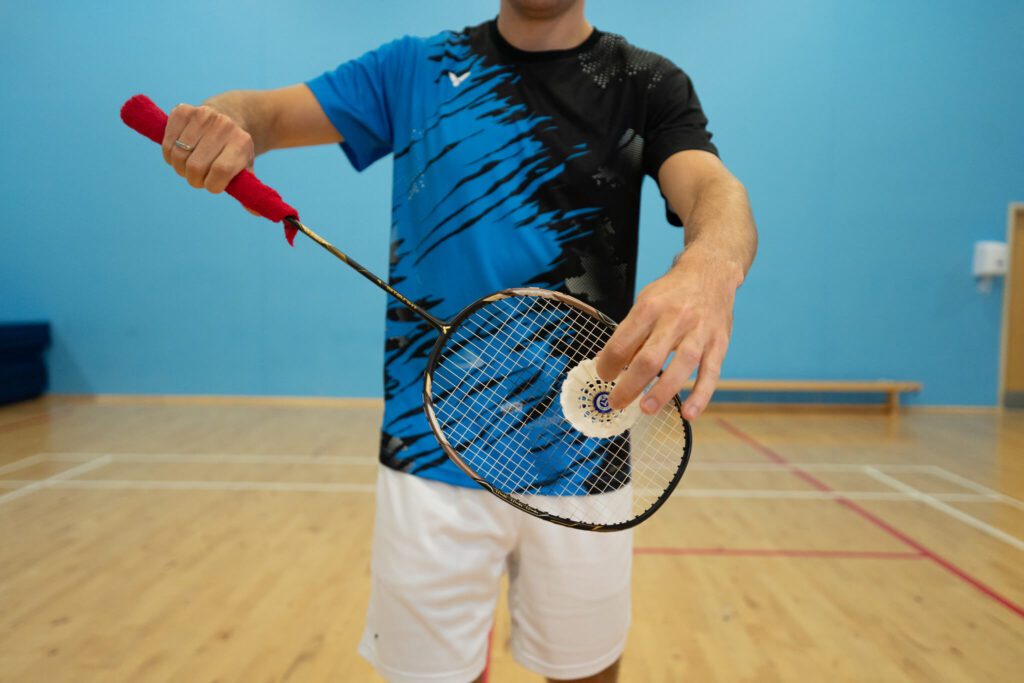
You might be wondering why not the middle of the strings, and this is for 2 main reasons:
- You have a higher chance of hitting your hand if you hit it in the middle of the racket (ouch!)
- The string bed is actually firmer in the corners of your racket which offers more control
💡 Top Tip: You want the shuttle to be dipping down as the opponent reaches it, so that they can’t get on top of the shuttle and attack the serve. Ideally, you should be forcing them to play an upwards shot!
Everything up until this point will be exactly the same for the flick or drive serve. But from here onwards they are of course slightly different.
The Hitting Action For A Backhand Flick Serve
To perform a normal flick serve:
- You need to have a short swing to maintain both control and deception in the shot, then use your fingers and thumb to squeeze your grip firmly to generate the power.
- Many players make the mistake of trying to create power solely from bending the wrist which leads to reduced control and deception, and also reduced power!
- You can read more about how to do a backhand flick serve here.
To perform a drive serve:
- You need to generate power in the shot using your fingers and thumb and proceed to hit the shuttle flat across the net.
- It is really important to have a short backswing and short follow through during this shot to make it as deceptive as possible and therefore catch your opponents out!
- You can learn more about the drive serve (or flat serve) here!
💡 Did You Know? The drive serve has only been used in the professional game since the adoption of the new serving rules. Many clubs still use the old service rules where the drive serve would be deemed illegal due to the racket head being above the racket handle at the point of contact.
Where You Should Serve To
There are 7 main serves in doubles (shown on a badminton court in the image below):
1 – To the T
2 – To the middle / body
3 – Out wide to the tramline
4 – Flick down the centre line
5 – Flick out wide
6 – Drive down the centre line
7 – Drive out wide
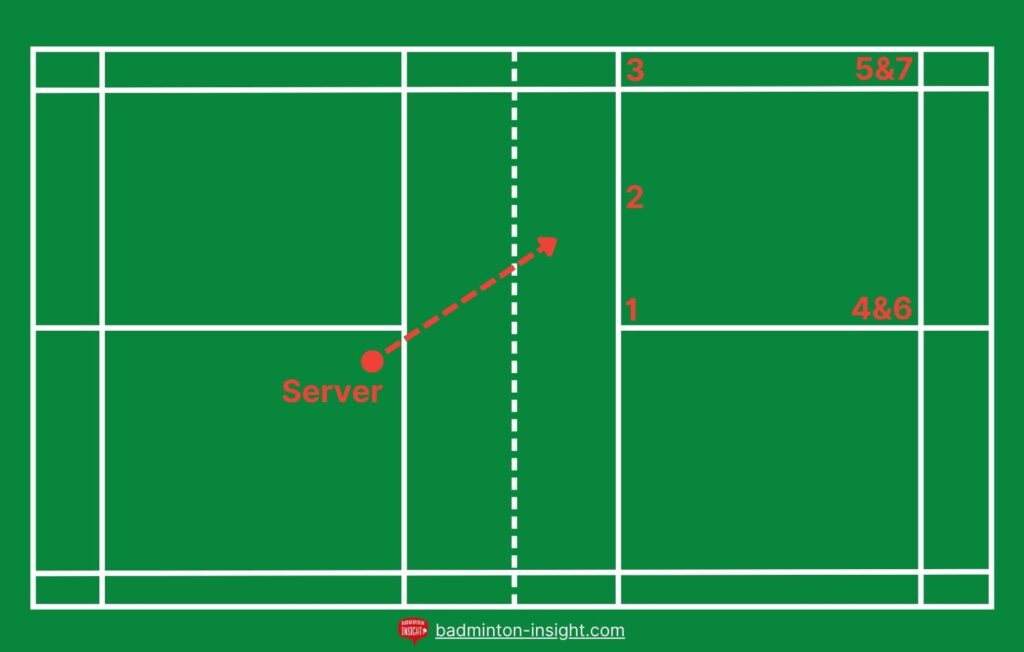
Unlike doubles, a flick serve down the middle is also often used in singles as this reduces the angle of the shot the opponent can play and avoids the risk of making a mistake.
Remember:
- Keep varying where you serve to so your opponent can’t anticipate where it’s going, therefore reducing the likelihood of them playing a winning return.
- However, if a particular serve is working very effectively and winning you lots of points, then you might want to keep it the same until it is no longer effective!
How To Practice Your Badminton Backhand Serve
Players often train for hours on the technical aspects of their game such as their smash or backhand, but often neglect practicing their serve!
So here are 3 ways to practice your backhand serve:
1. Simply stand and serve!
- Have several shuttles beside you and practice your serve
- Here you can experiment with different preparations and hitting actions
- As you get used to the technique, you can start adding targets and try aiming for the 7 different serve locations
2. Get someone to return your serves
- Whether it’s for singles or doubles, this makes you think a lot more about where you are serving to and what you expect the likely reply to be
- It can also add a bit of pressure when someone is standing there, which helps you get used to that feeling in a match
- To make sure you are ‘practicing to perform’, you can also try and move to the next shot (often the technique of your serve will be slightly different when you have to move straight after hitting it)!
3. Practice it in a routine or match
- We would advise regularly starting with a serve in training routines and we would always advise experimenting with your serve in matches against various oppositions.
- Of course if you are playing a very competitive match you want to win then stick to what works for you, but if you play lots of matches then try to mix it up from time to time. We have done this many times over the years and both of our serves are much better as a result!
- Players also have common returns they like to play, especially if you serve to certain areas. So if you can become better at recognising this and serving to these areas and predicting certain replies then you will become a much better badminton player.
💡 For example, if you serve across someone’s body to their forehand, they are likely to play it cross court since this follows the natural swing of their racket. If this is usually a net shot then you can anticipate this, or if it’s usually a flat shot you might try to intercept it!
Even though these practices are progressions from each other, they are all really great practices no matter what level of badminton player you are!
Learn More
There isn’t one perfect technique when it comes to the serve, even a lot of the professional players serve slightly differently. So experiment and figure out what works for you, and hopefully the guidance in this article can serve you well and help you head in the right direction!
And if you’re interested, you can watch our YouTube video on how to perform a backhand serve below, which also includes some set plays to help you win some quick points off the serve!
